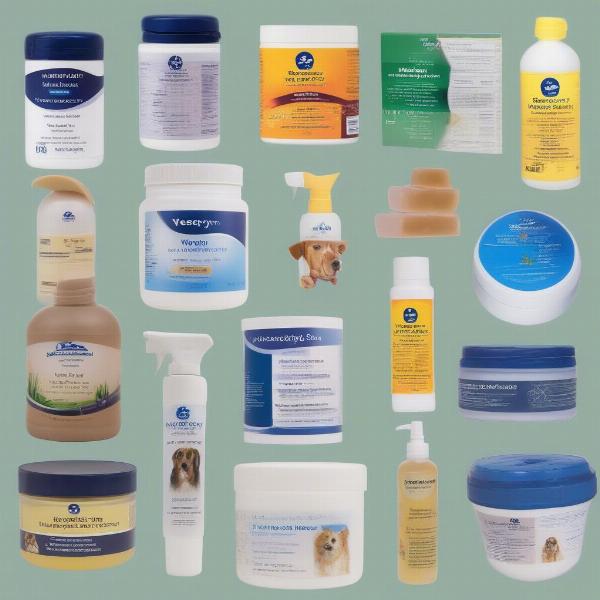Neosporin spray for dogs is a common topic for pet owners, sparking questions about its safety and effectiveness. This article will delve into the details of using Neosporin on your canine companion, covering everything from appropriate uses to potential risks and alternatives. Understanding how to properly care for minor wounds on your dog is crucial for their well-being, so let’s explore the world of Neosporin and canine wound care.
Understanding Neosporin and Its Ingredients
Neosporin is a topical antibiotic ointment often found in human first-aid kits. It contains three active ingredients: neomycin, polymyxin B, and bacitracin. These antibiotics work together to combat a broad spectrum of bacteria that can infect minor wounds. However, it’s important to note that not all Neosporin products are safe for dogs.
Is Neosporin Spray Safe for Dogs?
While generally considered safe for dogs in small amounts, the spray form of Neosporin is generally not recommended. Dogs often lick treated areas, and ingesting large amounts of the medication can cause digestive upset. Additionally, the spray can be difficult to apply precisely, increasing the risk of your dog inhaling the product. Opt for the ointment form instead. Always consult your veterinarian before using any medication on your dog, even over-the-counter products like Neosporin.
When to Use Neosporin on Your Dog
Neosporin is suitable for treating minor cuts, scrapes, and abrasions on dogs. It can help prevent bacterial infections and promote healing. However, it is not appropriate for deep wounds, puncture wounds, or burns. These types of injuries require professional veterinary attention.
How to Apply Neosporin Ointment to Your Dog
Before applying Neosporin, clean the affected area gently with warm water and a mild antiseptic solution. Pat the area dry with a clean cloth. Then, apply a thin layer of Neosporin ointment to the wound. Prevent your dog from licking the ointment for at least 10-15 minutes. You can use an Elizabethan collar (cone) to prevent licking.
Potential Side Effects of Neosporin in Dogs
While rare, some dogs may experience allergic reactions to Neosporin, such as skin irritation, redness, or itching. If you notice any of these symptoms, discontinue use and contact your vet. Excessive licking of Neosporin can also lead to gastrointestinal upset, including vomiting and diarrhea.
Alternatives to Neosporin for Dogs
Several alternatives to Neosporin can be used to treat minor wounds in dogs. These include Vetericyn Plus Antimicrobial Hydrogel, which is specifically formulated for animals, and natural remedies like honey or aloe vera (always consult your vet before using aloe vera).
 Alternative wound care products for dogs
Alternative wound care products for dogs
What to Do If Your Dog Licks Neosporin
If your dog licks a small amount of Neosporin, it’s usually not cause for alarm. However, if they ingest a significant amount, contact your veterinarian immediately. Monitor your dog for signs of gastrointestinal upset, such as vomiting or diarrhea.
Conclusion
Neosporin ointment can be a helpful tool in your dog’s first-aid kit for treating minor wounds. However, always prioritize consulting your veterinarian before using any medication on your dog. Remember to opt for the ointment form, apply it sparingly, and prevent your dog from licking the treated area. By understanding the appropriate uses and potential risks of Neosporin, you can ensure your furry friend receives the best possible care.
FAQ
- Can I use Neosporin spray on my dog? While the ointment form is generally preferred, the spray is not recommended due to the risk of inhalation and ingestion.
- What should I do if my dog has a deep wound? Seek immediate veterinary care for deep wounds, punctures, or burns.
- Are there any natural alternatives to Neosporin for dogs? Your vet may recommend alternatives like honey or specific pet-safe antimicrobial products.
- How can I prevent my dog from licking Neosporin? Use an Elizabethan collar (cone).
- What are the signs of a Neosporin allergy in dogs? Skin irritation, redness, and itching are potential signs of an allergy.
- Is Neosporin safe for puppies? Consult your veterinarian before using Neosporin on puppies.
- How long should I use Neosporin on my dog? Continue use as directed by your veterinarian.
Related Articles
ILM Dog is your trusted resource for comprehensive and practical dog care advice. We offer expert guidance on various topics, including breed selection, health care, training, nutrition, grooming, and much more. Whether you’re a new dog owner or a seasoned pro, we provide valuable insights to help you provide the best possible care for your canine companion. For personalized advice or more information, contact us at [email protected] or call us at +44 20-3965-8624. Visit ILM Dog today for all your dog care needs!